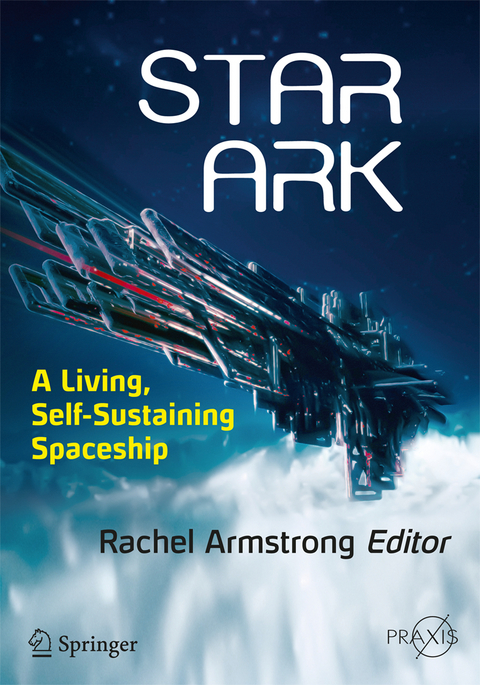
Star Ark
Springer International Publishing (Verlag)
978-3-319-31040-4 (ISBN)
Rachel Armstrong is a researcher developing novel sustainable technologies that harness some of the properties of life and has been developing a range of projects over the last 5 years that propose new approaches that are life-promoting rather than resource conserving. She has been developing prototypes and models for sustainable environmental technologies and collaborating with architectural practices and scientific research laboratories (University of Southampton, University of West England, University of Glasgow and the Southern University of Denmark). These prototypes have been recognized as having potential applications for industry and society, as noted in a Nature article. Armstong's interest in space dates back to the 1990s. Armstrong is project leader for the Icarus Interstellar group, working on laying the groundwork for the construction of a starship in Earth's orbit within a hundred years and is Director of The Institute for Interstellar Studies for Sustainability and the Environment. Throughout her career Armstrong has been recognized as a pioneer. The International Journal of Environmental Investing nominated her as among the most influential environmental academics in May 2014, and she was a coauthor on a paper published in 2013 for the International Journal of General Systems, awarded the distinction as best paper by Taylor & Francis. She has been named as one of the Wired 2013 Smart List, as one of the 2013 ICON 50 and one of the ten people in the UK that may shape the UK's economic recovery by Director Magazine in 2012. In the same year Armstrong was nominated as one of the most inspiring top nine women by Chick Chip magazine and as one of the BBC Focus Magazine's August 2011 edition's 'ideas that could change the world.' Her TED Talk "Architecture that repairs itself" was voted as #1 on Diane von Furstenberg's playlist and as #3 on Bjork's list of favorite talks, heard more than 750,000 times. She was recently appointed Professor of Experimental Architecture at the University of Newcastle.
Introduction by Rachel Armstrong.- Overview by Andrew Tziolas.- Metaphysics of Reality in Space by Rachel Armstrong.- Seeding the Universe with Life by Michael Mautner.- Space chemistry by Martin Hanczyc.- Living soils by Rachel Armstrong.- Bacterial worlds by Simon Park.- Nature in space by Koert van Mensvoort.- The experience of space by Nelly Ben Hayoum.- Space architecture by Richard Hyams.- Extremophiles by Sarah Jane Pell.-Shrinking the human by Arne Hendriks.- Human/mechanicals hybrids by Kevin Warwick.- Space birth by Lucy McCrae, Susan Crawford-Young, and Lynne Harper.- Establishing the ecological being by Rachel Armstrong.- Ecology of Mind by Noam Chomsky.- Humanity in space by Steve Fuller.- Ecological politics by Jane Bennett.- Very large organizations by Jordan Geiger.- Architects building planets by Mark Morris.
"The chapters are well referenced, giving readers the opportunity to follow-up points of interest. ... Professor Armstrong is to be congratulated on weaving together many different perspectives on the far future of space exploration - in an age of ultra-specialisation, that in itself is simulating and refreshing." (Ian Crawford, The Observatory, Vol. 137 (1261), December, 2017)
"This peculiar and interesting book is suitable if you are curious about the matter of long space travels, like e.g. hundreds of years, and the problem of the colonization of new worlds. The solution presented here is a serious study on the so-called 'generation ships', which are well-known among science-fiction readers. ... An intriguing book about an unusual subject." (Gabriella Bernardi, Astrocom et al., astrocometal.blogspot.de, January, 2017)| Erscheinungsdatum | 28.09.2016 |
|---|---|
| Reihe/Serie | Space Exploration | Springer Praxis Books |
| Zusatzinfo | XXII, 492 p. 127 illus., 107 illus. in color. |
| Verlagsort | Cham |
| Sprache | englisch |
| Maße | 168 x 240 mm |
| Themenwelt | Sachbuch/Ratgeber ► Natur / Technik ► Weltraum / Astronomie |
| Naturwissenschaften ► Physik / Astronomie ► Astronomie / Astrophysik | |
| Schlagworte | Aerospace Technology and Astronautics • Artificial Worlds Theory • Design, general • Ecological Challenges of Space Development • Ecology in Space • Ecosystem Construction • Extraterrestrial Physics, Space Sciences • Living Habitat in Space • Non-terrestrial Ecologies • Physics and Astronomy • Popular Science in Astronomy • Soil Use in Space • space colonization • Spreading Life Through Universe • Starship Design |
| ISBN-10 | 3-319-31040-2 / 3319310402 |
| ISBN-13 | 978-3-319-31040-4 / 9783319310404 |
| Zustand | Neuware |
| Haben Sie eine Frage zum Produkt? |
aus dem Bereich


